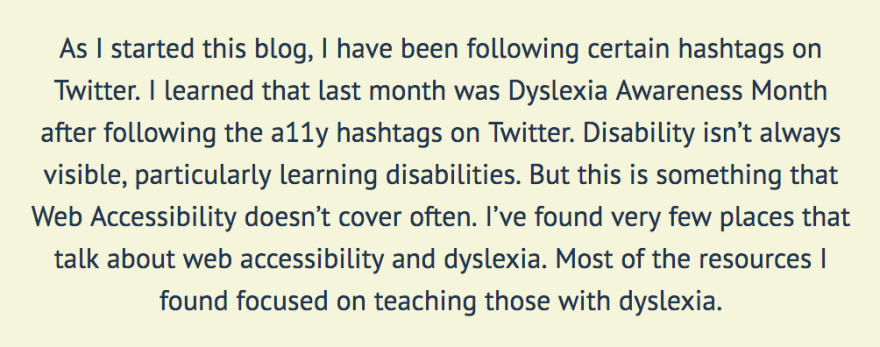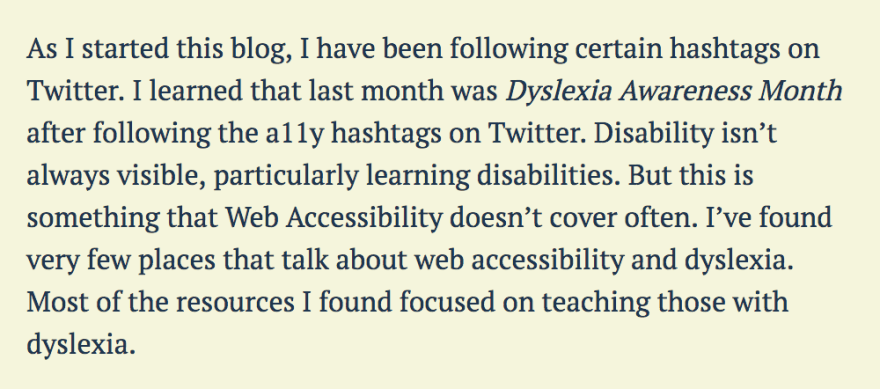As I started this blog, I began to follow specific hashtags on Twitter. I learned that last month was Dyslexia Awareness Month after following the a11y hashtags on Twitter. I’ve always said that disability isn’t always visible, mainly learning disabilities. However, this is something that Web Accessibility doesn’t cover often. I’ve found very few places that talk about web accessibility and dyslexia. Most of the resources I found focused on teaching those with dyslexia.
I’ve spent the last couple of weeks researching how to make my content more accessible to those who have dyslexia. I am learning along with you in this blog post. Here is what I’ve learned:
Style your copy properly
There are a few things that can contribute to the readability of your site. A couple I’ve found are text alignment and typography.
Text alignment
Ensure left alignment. Having a fixed left alignment makes it easier for people to find the next line of text. Proper text alignment helps all people, not only dyslexic users. This is bad:
Avoid justified text
The uneven spacing between the words trips people up. The reason for this is it causes dyslexic users to lose their place and start over. This is bad:
Typography
Write in sans serif. Something we do not think about is that serif’s add decoration. Serifs can be distracting, particularly for dyslexic users. Using sans serifs helps dyslexic users who tend to use their memory of shapes for letters. Also, italics can be problematic and blend with regular text. If you want emphasis, use bold text. This is bad (serif and italic):
I never realized how badly this impacts those with dyslexia. The great news is these fixes are straightforward. I have a few updates that I’d like to make to my site now that I’ve learned about how these issues impact dyslexic users.
Structure your content
This section is where I hear my Public Relations education come back. I remember my professors scolding any time I wrote verbose sentences or in a passive voice. Public Relations is about making information transparent and readable. We must ensure that your readers understand the point of your content.
This sentence was incredibly hard to decipher. It's gotta be me and not you.... brain so tired from reading and writing all day #dyslexia #NaNoWriMo
— Rachel is Writing (@RachelisScience) November 11, 2018
Let's break up a few of the things I learned.
Break up text
Use headings and images to break up large blocks of text. Breaking up long paragraphs gives people a break from a wall of text, which makes it more digestible for everyone. I do this frequently because it helps me to keep my key points clear.
Avoid Passive Voice
What is the active voice and the passive voice? Active voice is when there’s a definite subject of a sentence that is acting. Passive voice is when the subject is being acted upon. Here is an example of passive voice: “The change was approved by the committee.” Changing it to active voice is simple: “The committee approved the change.” Scientific writing tends to use passive voice, and the result of passive voice is sometimes wordy sentences.
Avoid Double Negatives
You may think it sounds sexy. However, it makes people second guess what you’re trying to say. Particularly those who have dyslexia. So say it directly. Use a positive instead of a double negative to convey a positive.
Tools to help with your content
I learned about the Hemingway app in my research. I used the Hemingway app while writing this post! By the way, if you are dyslexic, this app may not be the most ideal because it uses a serif font. The app tells you what reading level your writing is and how many characters and words. It’s a fantastic tool, and I’m excited to use it in my writing!
Don't change your content too quickly
Slideshows already annoy me as someone who doesn’t have dyslexia. Imagine going to a page that has a hero carousel. As you’re halfway through the sentence, it switches on you!
It is even worse for people with dyslexia, who tend to read slower. If you’re changing your content in a carousel, then you should give at least 25% more time than you’d think. Adding the extra time would help accommodate those who read a little bit slower.
What are some alternatives? It might be worth asking if there needs to be a carousel at all. Right now, singular heroes are more on trend than carousels. Can you include one hero image as the focal point of your text? If you have multiple pieces of content you’d like to showcase, provide an option to switch from one to the other manually.
Provide audio formats of your content
One of the best ways to help out our dyslexic users is to give people alternate formats, particularly audio or video. I can imagine if I had difficulty with a lot of text, having a different version would calm my anxieties. Empathize with your users by giving them the ability to choose how they digest your content. That way if they get frustrated with reading through your content, they can listen instead. Audio formats could also benefit users with visual impairments.
As of this date, I have been using my friend Kyle Galbraith's tool parler.io. It is a service that automatically creates an audio file for your blog posts, so long as your blog has an RSS feed. Super neat! This tool is currently free to use, and I love it!
If you don't want to use this service and creating your own audio files is outside of your budget, ensure that your web pages are screen reader friendly. From what I understand, dyslexic users sometimes use screen readers to assist them with content, so navigating a page with a screen reader should be intuitive.
Sources
I need to give credit where credit is due, because I barely had any information on dyslexia for web prior to writing this blog post. Below are the sources I used to research this and learn more information:
- Five ways to make usable websites for people with dyslexia
- 6 Surprising Bad Practices That Hurt Dyslexic Users
What are your thoughts on dyslexia for the web? Do you have Dyslexia? If so, I’d love to hear what helps you as I am learning as I go with this one. Feel free to reach out to me on Twitter if you have questions about this blog post.











Top comments (16)
Fantastic post. Im dyslexic myself and currently building a startup for a tool that helps people with dyslexia online.
This is it
robertgabriel.ninja/apps/helperbird
:)
Wow that is awesome! I'll check it out tonight :)
As the father of two dyslexic children, thanks.
It should be remembered that Dyslexia is different for each suffer. It's good to have a set of standards like you've given here to help as many as possible.
I agree! I've had some people tell me this is overkill, but I'd rather accommodate those that struggle the most because those fixes benefit everyone
I (would) benefit and I’m not dyslexic- to your point of “benefiting everyone”
Thanks. Bookmarked!
Wonderful! All things that we as creators very often neglect (for a plethora of reasons.)
My wife recently came across this: dyslexiefont.com/en/typeface/ which seems to help our son to read better. Might be useful to someone out there.
Thanks for sharing! I’ll also check it out!!
Great article, thanks for sharing. Are there any resources that you know of on how to write better code given some of the principles you lay out here? It seems like these can be applied to a wide range of writing scenarios including programming.
Excellent piece, and very useful, and particularly interesting is the use of screen readers, didn't know that.
I wrote a small post myself a while ago about dyslexia and fonts which you might find interesting: ashleysheridan.co.uk/blog/Dyslexia...
Thank you! I will check this out :D
Patients with aphasia suffer a type of dyslexia aswell. People need more awareness about accesibility. Thanks for writting this <3
thanks for sharing! so important to shed light on non-visible disabilities when talking about accessibility in tech, and i really appreciate you putting this on my radar to learn more about :)
Of course! I feel like cognitive disabilities aren't nearly as talked about in web accessibility so I wanted to put some new stuff out there.
Details are awesome and very useful in this post, and thanks for sharing this brilliant post.
1centhostingcoupon.com/
Thank you so much! I have a dyslexic child and I appreciate devs who make an effort for him.
Quite interesting post. I'll think about it when I develop my projects, it will surely help a lot of people